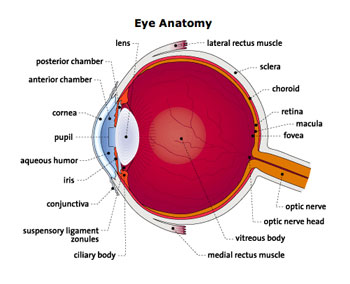Scheie Image Reading Center
The mission of the Scheie Image Reading Center is to advance the development of ophthalmic image interpretation and its role in advancing the understanding of treatments for preventing blindness through collaborative clinical research.
- What is an Image Reading Center?
- Reading Center Organization
- Staffing and General Procedures
- Photography protocols
- Certification procedures
- Grading Protocols
- Scheie Image Reading Center Services
- Ongoing studies served by the Scheie Image Reading Center
- Completed studies served by the Scheie Image Reading Center
- Reading Center Staff
- Contact us
What is an Image Reading Center?
The primary function of a Reading Center as a central resource center is to evaluate and interpret (read or grade) the pathology on fundus photographs, fluorescein angiograms, or other imaging modalities for specific studies. For more information on the organization of a Reading Center for a clinical trial click here [PDF, 44KB] and for staffing and general procedures, click here [PDF, 64K] .
Images are obtained following a specific photography protocol at the initial study visit to document pathology. When a study includes follow-up visits, photographs are usually obtained at these visits as well. The images of the follow-up visits are evaluated for changes in the pathology since the initial visit.
 The images are obtained with special cameras designed specifically to photograph the inside of the eye (click on eye graphic, right). Clinical centers participating in studies are required to meet strict qualifications and complete certification procedures in order to photograph study patients.
The images are obtained with special cameras designed specifically to photograph the inside of the eye (click on eye graphic, right). Clinical centers participating in studies are required to meet strict qualifications and complete certification procedures in order to photograph study patients.
How the images are interpreted by the readers for each study is described in a Grading Protocol. The Reading Center works closely with other resource centers, such as a Coordinating Center, in aspects of site monitoring, subject recruitment, screening, enrollment and retention, data and safety monitoring, data collection and analysis, adherence to the protocol directed procedures and guidelines and the prompt review of and reporting of adverse events. For more information on the Scheie Image Reading Center services, click here.
- Download the Reading Center Organization PDF, 44KB
- Download the Staffing and General Procedures PDF, 64KB
- More Information about Photography Protocols
- More Information about Certification Procedures
- More Information about Grading Protocols
- Scheie Image Reading Center Services
Ongoing studies served by the Scheie Image Reading Center:
- The Comparison of Age-Related Macular Degeneration Treatments Trials (CATT) is a set of multicenter, randomized clinical trials of treatments for neovascular age-related macular degeneration (AMD), the leading cause of blindness in the United States. The Lucentis-Avastin Trial, supported by the National Eye Institute will be the first CATT clinical trial.
- The Retinopathy in Chronic Renal Insufficiency (RCRIC) Study: RCRIC is a multi-centered research study that will investigate the effect that chronic kidney disease has on the eyes. The study involves photographing the retinas of people with chronic kidney disease. The information gathered from the photos will help researchers better understand the relationship between kidney disease, heart disease, and eye conditions. CPOB serves as both the Coordinating Center and Reading Center for the RCRIC study, which is funded by the National Institute of Diabetes, Digestive, and Kidney Diseases (NIDDK).
Completed studies served by the Scheie Image Reading Center:
- The Complications of Age-related Macular Degeneration Prevention Trial (CAPT): CAPT was an NEI-sponsored, randomized, clinical trial involving 23 clinical centers nationwide, 1000 patients, and an annual budget of $3 million. The trial evaluated laser treatment among patients at high risk of developing severe loss of vision from age-related macular degeneration, the leading cause of blindness in the United States and many other western countries. The CPOB served as both the CAPT Coordinating Center and the CAPT Fundus Photograph Reading Center. This trial was completed in 2008.
- AMD and Alzheimer’s Disease (AMDAD) Study: CPOB served as both the Coordinating Center and Reading Center for the AMDAD study, which examined the relationship between age-related macular degeneration and Alzheimer’s Disease. The question was of interest because the composition of drusen in the retina (which signals the presence of macular degeneration) is similar to the composition of substances that are found in the brains of people with Alzheimer’s Disease. The AMDAD study photographed the retinas of people with early stages of Alzheimer’s Disease to ascertain if these patients also had higher concentrations of drusen. The study was funded by the Scheie Macula Research Fund and was a collaborative effort among CPOB, the Penn Low Vision Center and the Memory Disorders Clinic at Penn’s Institute on Aging.
- The Choroidal Neovascularization Prevention Trial (CNVPT; 1994-2000), sponsored in part by the National Eye Institute (NEI) was a pilot randomized trial of laser photocoagulation in eyes at high risk of choroidal neovascularization secondary to age-related macular degeneration. The CNVPT included 276 patients, 15 clinical centers, and resulted in 6 peer-reviewed publications.
- Age-Related Macular Degeneration and Radiotherapy Trial (AMDRT; 2000-2003): CPOB staff served as the Coordinating Center for the AMDRT, an NEI sponsored pilot study to evaluate the safety and feasibility of conducting a large-scale trial of radiotherapy for eyes with neovascular AMD. The AMDRT included 88 patients, 10 clinical centers and resulted in one peer reviewed publication. AMDRT involved coordination of patient visits to multiple medical specialty services. Results of the pilot study did not support a full-scale trial.
Scheie Image Reading Center Staff
For each clinical trial, a specialized team comprised of an Ophthalmologist, a Director, and Photograph Readers collaborate with a study Coordinating Center to develop protocols and procedures to best meet the individual needs of the study. The Reading Center often collaborates with the CPOB Coordinating Center.
Click here to learn more about the Reading Center staff.
For additional SIRC information, contact us.
